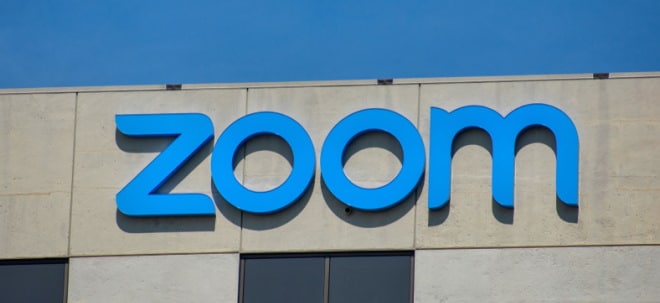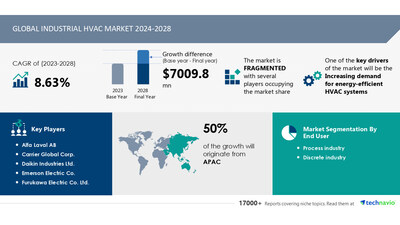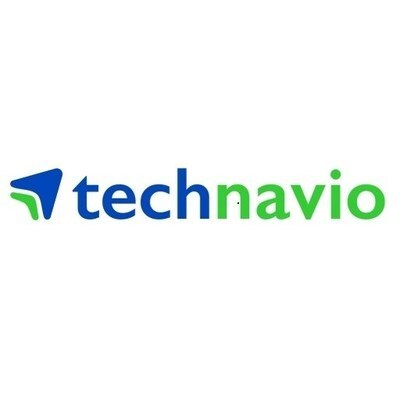Industrial HVAC Market to Grow by USD 7.01 Billion (2024-2028), Driven by Demand for Energy-Efficient Systems, Market Evolution Powered by AI - Technavio
NEW YORK, Nov. 21, 2024 /PRNewswire/ -- Report on how AI is driving market transformation - The global industrial HVAC market size is estimated to grow by USD 7.01 billion from 2024-2028, according to Technavio. The market is estimated to grow at a CAGR of 8.63% during the forecast period. Increasing demand for energy-efficient hvac systems is driving market growth, with a trend towards growing adoption of advance refrigerants in air conditioners. However, frequent change in regulation pertaining to industrial hvac poses a challenge. Key market players include Alfa Laval AB, Carrier Global Corp., Daikin Industries Ltd., Emerson Electric Co., Furukawa Electric Co. Ltd., Hitachi Ltd., Honeywell International Inc., Ingersoll Rand Inc., Johnson Controls International Plc., Lennox International Inc., LG Electronics Inc., MIDEA Group Co. Ltd., Mitsubishi Electric Corp., Panasonic Holdings Corp., Robert Bosch GmbH, Samsung Electronics Co. Ltd., Shield Air Solutions Inc., Specific Systems LLC, Stryker Corp., and WHESCO Group Inc..
Key insights into market evolution with AI-powered analysis. Explore trends, segmentation, and growth drivers- View Free Sample PDF
Industrial HVAC Market Scope | |
Report Coverage | Details |
Base year | 2023 |
Historic period | 2018 - 2022 |
Forecast period | 2024-2028 |
Growth momentum & CAGR | Accelerate at a CAGR of 8.63% |
Market growth 2024-2028 | USD 7009.8 million |
Market structure | Fragmented |
YoY growth 2022-2023 (%) | 7.76 |
Regional analysis | APAC, Europe, North America, South America, and Middle East and Africa |
Performing market contribution | APAC at 50% |
Key countries | US, Germany, UK, Japan, and China |
Key companies profiled | Alfa Laval AB, Carrier Global Corp., Daikin Industries Ltd., Emerson Electric Co., Furukawa Electric Co. Ltd., Hitachi Ltd., Honeywell International Inc., Ingersoll Rand Inc., Johnson Controls International Plc., Lennox International Inc., LG Electronics Inc., MIDEA Group Co. Ltd., Mitsubishi Electric Corp., Panasonic Holdings Corp., Robert Bosch GmbH, Samsung Electronics Co. Ltd., Shield Air Solutions Inc., Specific Systems LLC, Stryker Corp., and WHESCO Group Inc. |
Market Driver
The Industrial HVAC market is experiencing significant growth due to the increasing demand for energy-efficient and sustainable climate control solutions in residential, commercial, and industrial buildings. Heating, cooling, and climate control technologies are essential for thermal comfort and indoor air quality, especially in light of climatic changes and long-term climate change impacts. The construction sector, including residential and commercial construction activities, is driving demand for HVAC systems in new housing units and infrastructure projects due to rapid urbanization. Energy consumption is a major concern, with air conditioners, programmable thermostats, and specialized equipment playing crucial roles in cost savings and environmental sustainability. Maintenance, repair, and installation costs are key factors influencing consumer groups' purchasing decisions. HVAC industry consultants are advocating for smart HVAC systems utilizing the Internet of Things and real-time data for optimal temperature and humidity control. The HVAC industry is adapting to these trends by launching new energy-efficient product lines, such as heat pumps and energy-saving air conditioners, and offering financing options to make these solutions more affordable. HVAC regulations and environmental concerns are pushing the industry to address energy consumption, carbon footprints, and hazardous materials like fluorocarbons and fluoro coating agents. In the industrial sector, HVAC systems are essential for maintaining comfortable indoor environments in various applications, including data centers, hospitals, and commercial construction projects. Energy usage, electronic components, and ventilation are critical factors in these settings. In conclusion, the Industrial HVAC market is evolving to meet the demands of energy efficiency, sustainability, and affordability in various sectors, from residential to industrial. Trained professionals and specialized equipment are crucial for ensuring system reliability and longevity, while consumer education and awareness are essential for driving demand for cost-effective and energy-efficient HVAC solutions.
The industrial HVAC market is shifting towards advanced refrigerants with improved efficiency and lower environmental impact. Traditional refrigerants like CFCs, HCFCs, ammonia, and halons are being replaced due to their high global warming potential (GWP). To meet the rising demand for energy-efficient and eco-friendly systems, companies are developing new HVAC solutions, such as Variable Refrigerant Flow (VRF) systems. This trend is expected to boost the global adoption of these systems and drive growth in the industrial HVAC market.
Request Sample of our comprehensive report now to stay ahead in the AI-driven market evolution!
Market Challenges
- The Industrial HVAC market faces several challenges in providing energy-efficient and sustainable climate control solutions for various building sectors. These include residential, commercial, and industrial buildings, each requiring unique heating, cooling, and climate control technologies. Energy consumption is a major concern, with air conditioners and HVAC systems being significant contributors. Climatic changes and long-term climate change also impact the demand for HVAC systems. The construction sector, including residential and industrial sectors, undergoes rapid urbanization and housing unit construction, necessitating comfortable indoor environments with good indoor air quality. Thermal comfort and energy efficiency are essential for consumer groups, driving the demand for programmable thermostats, maintenance, repair, and installation costs. The HVAC industry consultants the importance of energy-efficient products like heat pumps, energy-saving products, and HVAC regulations. However, the initial cost and purchasing, financing options, and affordability remain significant barriers. Smart HVAC systems, using the Internet of Things, offer real-time data, cost savings, and system control, addressing energy consumption and environmental concerns. The HVAC infrastructure requires specialized equipment, trained professionals, and replacement parts for system failures. HVAC systems, including commercial and domestic systems, must ensure temperature, humidity, and environmental factor control for various applications, such as data centers, hospitals, and shopping malls. The lifespan and mortality rate of HVAC systems impact the standard of living and medical technologies, requiring ongoing maintenance and upgrades. HVAC systems include various components, such as thermostats, dampers, condenser fans, compressors, evaporators, blowers, chillers, coolers, cooling towers, VRF systems, and cooling equipment. New construction and retrofit projects require energy-efficient cooling systems, and various industries, including defense, electronics, and power solutions, utilize HVAC systems for their operations. The HVAC market also faces challenges from environmental hazards, carbon footprints, and HVAC regulations. The HVAC industry must address these challenges through education, training programs, and cost-effective solutions, ensuring a sustainable future for energy-efficient heating, cooling, and climate control technologies.
- Industrial HVAC market requires manufacturers to prioritize regulatory compliance when designing systems. Regulations aim to reduce carbon emissions and improve energy efficiency. However, these regulations vary regionally, making it challenging for vendors to meet each region's specific requirements. This hinders business expansion. The explosive industrial environments demand equipment to withstand extreme operational conditions. New regulations due to industrial accidents intensify product development. Manufacturers must balance regulatory compliance with product innovation to cater to diverse industries and regions.
Discover how AI is revolutionizing market trends- Get your access now!
Segment Overview
This industrial hvac market report extensively covers market segmentation by
- 1.1 Process industry
- 1.2 Discrete industry
- 2.1 HVAC equipment
- 2.2 HVAC services
- 3.1 APAC
- 3.2 Europe
- 3.3 North America
- 3.4 South America
- 3.5 Middle East and Africa
1.1 Process industry- The process industry segment, which includes oil and gas, power, pulp and paper, water and wastewater treatment, chemical and petrochemical, mining and metal, pharmaceutical, and food and beverages industries, dominates the global industrial HVAC market. This is due to increasing government regulations and rising energy costs, which are encouraging these industries to minimize energy usage in their manufacturing processes. Additionally, there is growing awareness among end-users regarding energy efficiency and environmental sustainability, leading in demand for energy-efficient industrial HVAC systems in the process industry. Furthermore, in industrial settings, the risk of explosion due to dust, chemical, or vapor leaks during operations is a constant concern, particularly in the oil and gas, chemical and petrochemical, and mining industries. These industries are classified as highly explosive industrial environments. The escalating number of accidents in such process industries has heightened safety concerns, leading to a significant increase in demand for explosion-proof HVAC systems. In the pharmaceutical industry, solid ingredients used in the formulation of pharmaceutical oral solid dosage forms can be combustible. Flammable solvents such as isopropyl alcohol, methanol, and acetone, which are used as tablet coatings, must be processed in a controlled environment. These requirements have led to the widespread use of cleanrooms in the pharmaceutical industry, which necessitates the installation of HVAC systems designed to meet these stringent standards. The stable growth of the process industry segment in the global industrial HVAC market can be attributed to increasing investments in the chemical and petrochemical and food and beverages industries. Moreover, the need to prevent dust-related explosions will further fuel the demand for explosion-proof HVAC systems from the food and beverages and pharmaceutical industries during the forecast period.
Download a Sample of our comprehensive report today to discover how AI-driven innovations are reshaping competitive dynamics
Research Analysis
The Industrial HVAC market is witnessing significant growth due to the increasing demand for energy-efficient climate control technologies in industrial buildings. Sustainable buildings, including residential and commercial structures, are prioritizing HVAC systems to ensure thermal comfort and indoor air quality. Space cooling and heating applications are essential for industrial buildings to maintain optimal working conditions and enhance the standard of living for workers. Climate control technologies, including thermostats, dampers, condenser fans, compressors, and evaporators, play a crucial role in regulating temperature, humidity levels, and indoor air quality. The commercial sector's infrastructure development and the construction of affordable housing units further boost product demand. The lifespan and mortality rate of HVAC systems significantly impact the overall cost-effectiveness and sustainability of industrial buildings.
Market Research Overview
The Industrial HVAC market encompasses energy-efficient climate control technologies for industrial buildings, focusing on heating, cooling, and thermal comfort in various structures. These include residential, commercial, and industrial buildings, each with unique humidity and ambient temperature requirements. Climatic changes and long-term climate change influence energy consumption, necessitating sustainable solutions. HVAC systems are essential for maintaining comfortable indoor environments, ensuring good indoor air quality, and adapting to construction activities driven by rapid urbanization and housing unit development. Key factors shaping the market include energy efficiency, consumer groups, HVAC industry consultants, maintenance, repair, and installation costs, system failures, replacement parts, and the Internet of Things (IoT) enabling smart HVAC systems. Real-time data collection and analysis enable cost savings, operator efficiency, and environmental considerations. The construction sector, residential sector, and industrial sector are significant markets for HVAC infrastructure. Rapid urbanization and the need for affordable housing units, commercial infrastructure, and maintaining a standard of living drive product demand. Energy-efficient products, such as heat pumps and programmable thermostats, are increasingly popular due to tax rebates, federal tax credits, and energy-saving incentives. HVAC systems include various components, such as air conditioners, dampers, condenser fans, compressors, evaporators, blowers, data centers, and cooling systems. Operating expenses, heating type, furnaces, boilers, ventilation type, humidifiers, dehumidifiers, air purifiers, ventilation fans, air handling units, implementation type, room air conditioners, unitary air conditioners, chillers, coolers, cooling towers, VRF systems, cooling equipment, and new construction or retrofit projects are all part of the HVAC industry. Industries such as hospitals, shopping malls, restaurants, commercial construction, and defense, electronics, automotive, and mobility sectors rely on HVAC systems for their operations. Energy-efficient cooling systems, product lines, and new product launches are essential for meeting the evolving needs of these industries. Additionally, chemicals, oil hydraulics, natural gas, petroleum and chemicals, mineral resources, and industrial infrastructure are significant markets for HVAC systems and related components. The HVAC industry faces challenges such as a lack of awareness, education, and affordability, particularly in emerging markets. Training programs, financing options, and cost-effective solutions are essential for addressing these challenges and driving growth in the market. HVAC regulations, environmental hazards, and carbon footprints are also important considerations for the industry.
Table of Contents:
1 Executive Summary
2 Market Landscape
3 Market Sizing
4 Historic Market Size
5 Five Forces Analysis
6 Market Segmentation
- End-user
- Process Industry
- Discrete Industry
- Type
- HVAC Equipment
- HVAC Services
- Geography
- APAC
- Europe
- North America
- South America
- Middle East And Africa
7 Customer Landscape
8 Geographic Landscape
9 Drivers, Challenges, and Trends
10 Company Landscape
11 Company Analysis
12 Appendix
About Technavio
Technavio is a leading global technology research and advisory company. Their research and analysis focuses on emerging market trends and provides actionable insights to help businesses identify market opportunities and develop effective strategies to optimize their market positions.
With over 500 specialized analysts, Technavio's report library consists of more than 17,000 reports and counting, covering 800 technologies, spanning across 50 countries. Their client base consists of enterprises of all sizes, including more than 100 Fortune 500 companies. This growing client base relies on Technavio's comprehensive coverage, extensive research, and actionable market insights to identify opportunities in existing and potential markets and assess their competitive positions within changing market scenarios.
Contacts
Technavio Research
Jesse Maida
Media & Marketing Executive
US: +1 844 364 1100
UK: +44 203 893 3200
Email: media@technavio.com
Website: www.technavio.com/
![]() View original content to download multimedia:https://www.prnewswire.com/news-releases/industrial-hvac-market-to-grow-by-usd-7-01-billion-2024-2028-driven-by-demand-for-energy-efficient-systems-market-evolution-powered-by-ai---technavio-302311780.html
View original content to download multimedia:https://www.prnewswire.com/news-releases/industrial-hvac-market-to-grow-by-usd-7-01-billion-2024-2028-driven-by-demand-for-energy-efficient-systems-market-evolution-powered-by-ai---technavio-302311780.html
SOURCE Technavio



